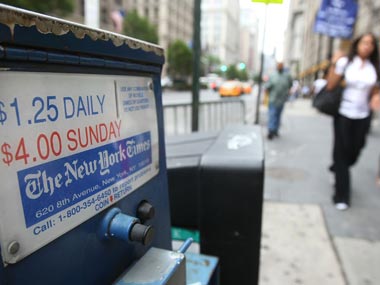The New York Times Company yesterday announced the results for the fourth quarter of 2012. Detailed results can be seen here.
What is noteworthy and what should delight newspaper owners across the world is that, for the first time, NYTCo’s revenues from circulation overtook the revenues from advertising.
“2012 showed both the opportunities and challenges we face as a company,” said Mark Thompson, president and chief executive officer. “We saw continued strong growth in digital subscriptions as well as increased revenue from our large print circulation base. Indeed, for the first time in our history, annual circulation revenues surpassed those from advertising. Our pay model continued to prove itself, with approximately 668,000 paid digital subscriptions across the Company at quarter end, up 13 percent from the end of the third quarter.”
[caption id=“attachment_618394” align=“alignleft” width=“380”] Ensuring differentiation and high quality is the only route to increasing circulation revenue in an Indian context.[/caption]
Ensuring differentiation and high quality is the only route to increasing circulation revenue in an Indian context.[/caption]
It’s a much more difficult task in India, considering the prevailing business model which sees abysmally low cover prices. “In most Asian countries, advertising accounts for 50 % (in India up to 80 %) of the total revenues among English newspapers,” reports this study on newspaper business models across the world .
Will readers in India pay more for their newspapers? This is not as easy as one might like. Mark Thompson, president and chief executive officer of The New York Times Company, had this to say while announcing the results.
“The demonstrated willingness of users here and around the world to pay for the high quality journalism for which The New York Times and the Company’s other titles are renowned will be a key building block in the strategy for growth.” Emphasis is _Firstpost’_s.
Ensuring differentiation and high quality is the only route to increasing circulation revenue in an Indian context. It’s bad enough that cover prices are low for the print editions; what makes the future more difficult is that, as of today, almost all digital editions are free. The flat readership seen through the latest data from the Indian Readership Survey point to the lack of interest in the printed form even at these low cover prices.
Impact Shorts
More ShortsDigital offers the obvious upside of savings in paper, printing and distribution costs, but has the startlingly dangerous downside of significantly lower advertising revenues.
Newspapers in India will have to bite the bullet sooner rather than later and evolve a strategy to increase their circulation revenues - but that strategy must, as Mark Thompson says, involve high quality journalism.
Compounding the problems for traditional print products is the emergence of pure digital news products including Firstpost, where the business models and business strategies see much greater efficiency in the news room.
Anant Rangaswami was, until recently, the editor of Campaign India magazine, of which Anant was also the founding editor. Campaign India is now arguably India's most respected publication in the advertising and media space. Anant has over 20 years experience in media and advertising. He began in Madras, for STAR TV, moving on as Regional Manager, South for Sony’s SET and finally as Chief Manager at BCCL’s Times Television and Times FM. He then moved to advertising, rising to the post of Associate Vice President at TBWA India. Anant then made the leap into journalism, taking over as editor of what is now Campaign India's competitive publication, Impact. Anant teaches regularly and is a prolific blogger and author of Watching from the sidelines.
)